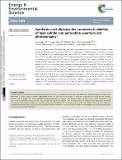Synthesis cost dictates the commercial viability of lead sulfide and perovskite quantum dot photovoltaics
Author(s)
Jean, Joel; Xiao, Justin T.; Nick, Robert J.; Moody, Nicole Susanne; Nasilowski, Michel; Bawendi, Moungi G; Bulovic, Vladimir; ... Show more Show less
Downloadc8ee01348a.pdf (4.314Mb)
PUBLISHER_CC
Publisher with Creative Commons License
Creative Commons Attribution
Terms of use
Metadata
Show full item recordAbstract
Any new solar photovoltaic (PV) technology must reach low production costs to compete with today’s market- leading crystalline silicon and commercial thin-film PV technologies. Colloidal quantum dots (QDs) could open up new applications by enabling lightweight and flexible PV modules. However, the cost of synthesizing nanocrystals at the large scale needed for PV module production has not previously been investigated. Based on our experience with commercial QD scale-up, we de velop a Monte Carlo model to analyze the cost of synthesizing lead sulfide and metal halide perovskite Q Ds using 8 different reported synthetic methods. We also analyze the cost of solution-phase ligand exchange for p reparing deposition-ready PbS QD inks, as well as the manufacturing cost for roll-to-roll solution-processe d PV modules using these materials. We find that present QD synthesis costs are prohibitively high for PV applications, with median costs of 11 to 59 $ per g for PbS QDs (0.15 to 0.84 $ per W for a 20% efficient cell) and 73 $ per g for CsPbI₃ QDs (0.74 $ per W). QD ink preparation adds 6.3 $ per g (0.09 $ per W). In total, QD materials contribute up to 55% of the total module cost, making even roll-to-roll-processed QDPV modules significantl y more expensive than silicon PV modules. These results suggest that the development of new lo w-cost synthetic methods is critically important for the commercial relevance of QD photovoltaics. Using our cost model, we identify strategies for reducing synthetic cost and propose a cost target of 5 $ per g to move QD solar cells closer to commercial viability
Date issued
2018-07Department
Massachusetts Institute of Technology. Department of Chemistry; Massachusetts Institute of Technology. Department of Electrical Engineering and Computer Science; Massachusetts Institute of Technology. Department of Physics; Massachusetts Institute of Technology. Research Laboratory of ElectronicsJournal
Energy & Environmental Science
Publisher
Royal Society of Chemistry
Citation
Jean, Joel, Justin Xiao, Robert Nick, Nicole Moody, Michel Nasilowski, Moungi Bawendi, and Vladimir Bulović. “Synthesis Cost Dictates the Commercial Viability of Lead Sulfide and Perovskite Quantum Dot Photovoltaics.” Energy & Environmental Science (2018).
Version: Final published version
ISSN
1754-5692
1754-5706